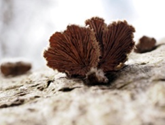Franchises
Lodge is a nature reserve covering almost 1000 acres. In 2018 it was acquired
by RSPB, whose impressive long-term vision for habitat restoration of the
woodland, and development of open heath is already evident. An important
objective is the development of a “bridge” between Langley Wood to the north
and the wider New Forest to the south. (1 on the map)
 |
Saul Alonso giving us an introduction to the reserve
© Tina Vaughan |
On a
bright sunny morning, a group of us gathered to meet Saul Alonso, the RSPB
Warden in sole charge of the reserve. Saul provided us with a background to the
estate and the geography of the surrounding land before heading off down the
bridleway and onwards into the private reserved area. Walking through the mixed
broadleaf woodland we heard numerous birds including Blue, Great and Coal Tits,
Wren, Blackbird, Chaffinch, Firecrest, Siskin and Blackcap, though we often had
only fleeting glimpses of bird life through the growing canopy of leaves.
 |
Nest boxes at Cameron's Cottage
© Tina Vaughan |
We paused
at Cameron’s Cottage; a formerly derelict building that has been completely
refurbished by the Cameron Bespolka Trust in partnership with the RSPB (2).
Much of the restoration has taken the cottage completely “off grid” using solar
powered heating and electricity as much as possible. Bat, Swift and House
Martin boxes have been installed during building. A hibernaculum for reptiles
and a very well appointed bug hotel (formerly an outside lavatory) have been
built in the surrounding grounds. A Grey Wagtail flew in carrying food and
obligingly perched in a nearby tree for the photographers.
 |
Grey Wagtail with food near Cameron's Cottage
© Chris Robinson |
Following
down the footpath we came to an area of Scots Pine where the sheer scale of
Rhododendron clearance and the challenge ahead were evident. This non-native,
invasive species has engulfed large swathes of the woodland, much to the
detriment of the habitat. This is being systematically removed and burned on
site with a long-term plan for eventual eradication which is expected to take
many years to complete. Radical management and culling of deer, predominantly
Fallow doe has already been undertaken. An initial survey suggested as many as
2000 deer were entering and grazing the reserve preventing any woodland
regeneration.
 |
Small-flowered Wintercress
© Richard Smith |
 |
Herb Robert
© Chris Robinson |
Further
on, we stopped for our coffee break at what had been dump where fly-tipping had
been a major problem in the past. Much of this has been cleared and the remaining
rubble, and mounds of earth are already colonised with Buddleia and wildflowers
plus some probably garden escapes. A long-term plan is to develop this are for
reptiles and for a butterfly bank. Goldfinches were seen feeding amongst the
nettles and waste ground. The botanist in the group identified numerous wild
plants including Small-flowered Wintercress, Dove’s-foot Cranesbill, Herb
Robert, Verbascum sp, Ivy-leaved Toadflax, Spear Mint, Lemon Balm and
Hedge Garlic.
 |
Germander Speedwell
© Tina Vaughan |
 |
Yellow Pimpernel
© Chris Robinson |
Walking
along the path beside the pylons that thread across the lower part of the
reserve, we saw more Greenfinches and a Common Buzzard circled overhead, Along
the path, we identified Tansy, Germander and Wood Speedwells, Lesser Trefoil,
Marsh Thistle, Silverweed, Yellow Pimpernel, Greater Stitchwort and Wood Spurge.
 |
Speckled Yellow (moth)
© Richard Smith |
 |
| Carder Bee © Tina Vaughan |
We
returned to the cars up a steep climb, passing behind Cameron’s Cottage where
we saw more Blue and Coal Tits and a Dunnock. An enjoyable and inspiring visit
to this site which is already providing access and education for young people
and has an ambitious and exciting future development plan.
References
1/ ‘Secret
forest’ becomes one of the RSPB’s most significant purchases : https://www.rspb.org.uk/about-the-rspb/about-us/media-centre/press-releases/franchises-lodge/
2/
Cameron's Cottage In partnership with the RSPB in the New Forest : https://www.cameronbespolka.com/cameron-s-cottage
 |
Franchises Lodge route
© Crown copyright 2022 Ordnance Survey. Media 005/22. The licence is valid until 31 December 2022. |




.JPG)

.JPG)
.JPG)




















